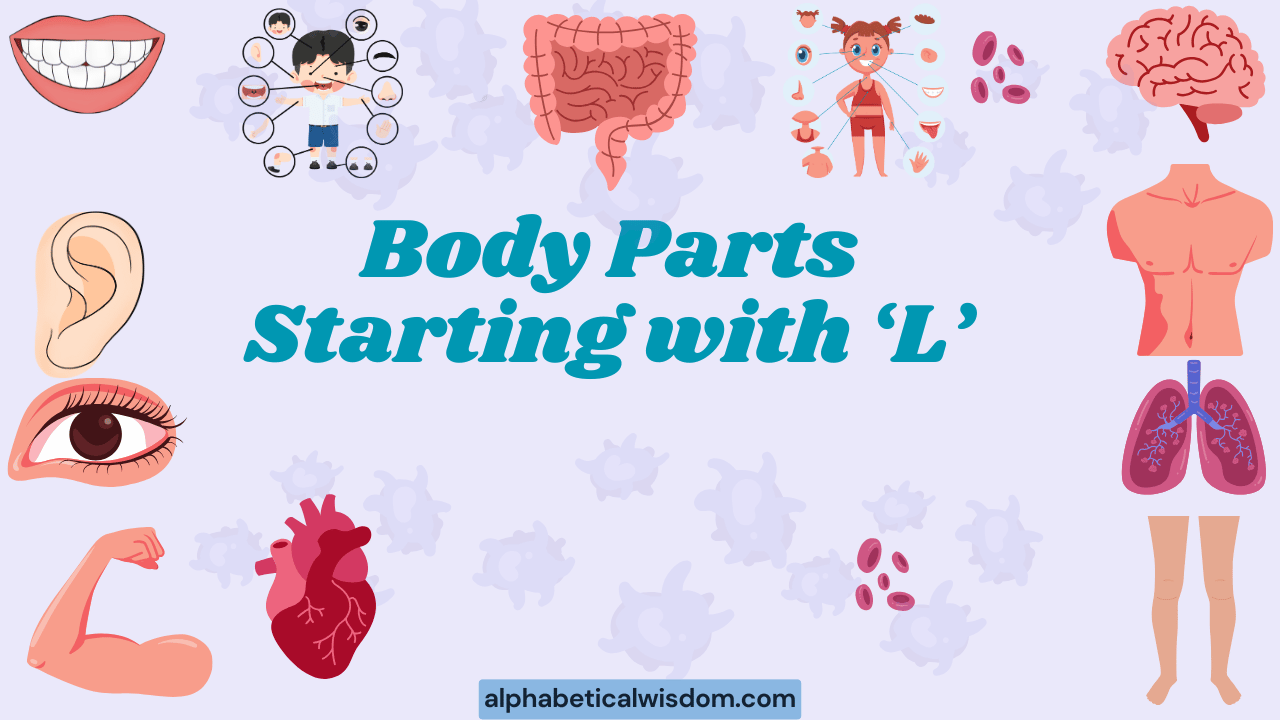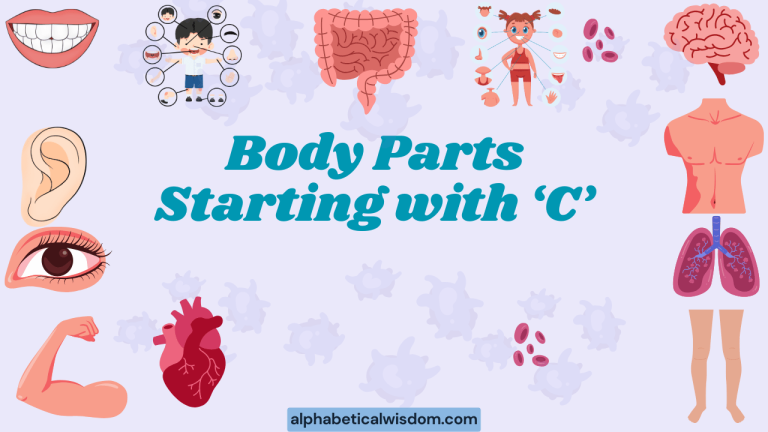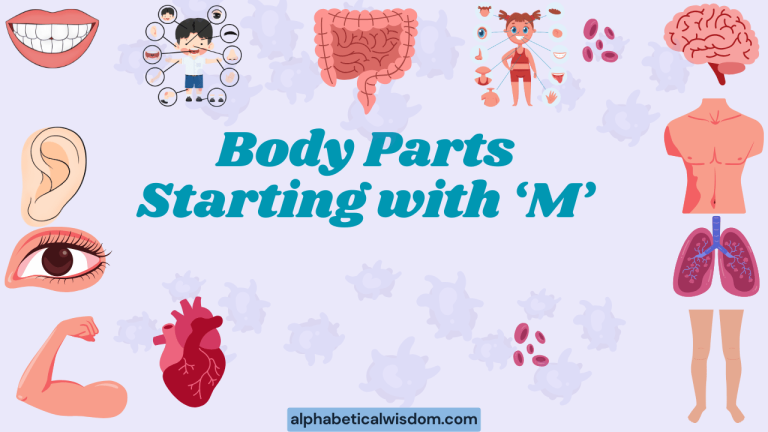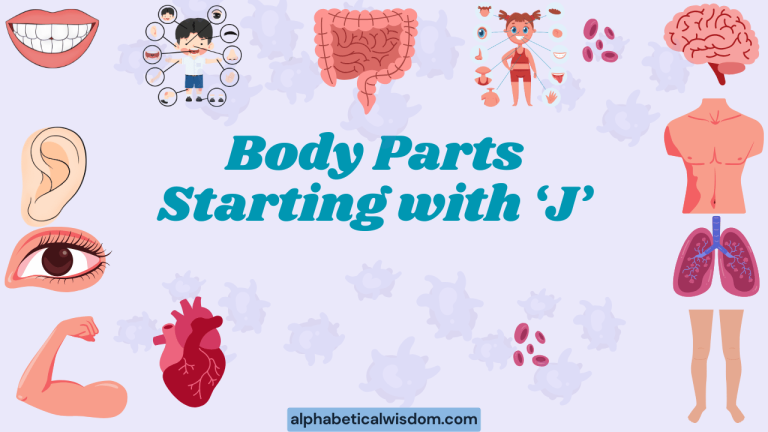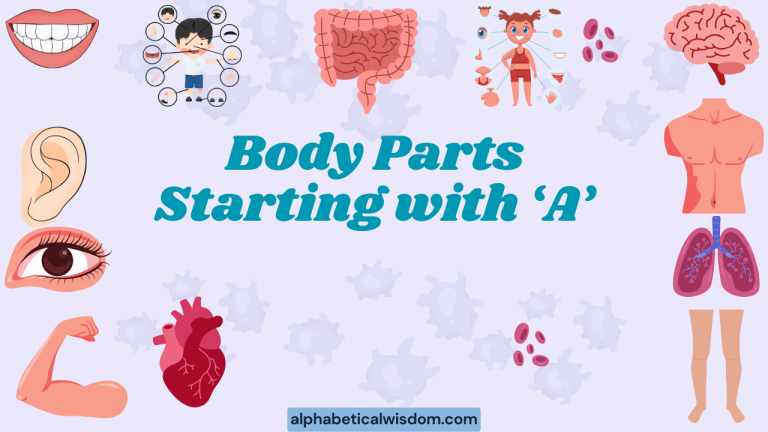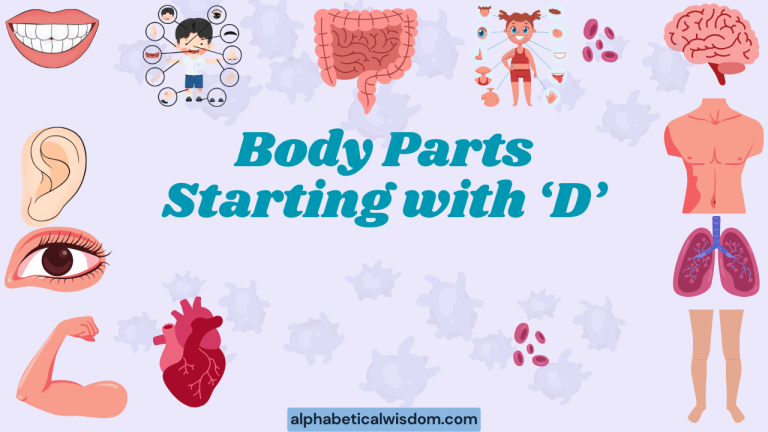Body Parts Starting with L: A Comprehensive Grammar Guide
Understanding body parts is fundamental to everyday communication in English. This article focuses specifically on body parts that begin with the letter “L,” exploring their grammatical roles and usage.
Mastering this vocabulary enhances your ability to describe physical attributes, discuss health, and engage in nuanced conversations. This guide is beneficial for English language learners of all levels, from beginners expanding their basic vocabulary to advanced speakers refining their precision and fluency.
Table of Contents
- Introduction
- Definition of Body Parts Starting with L
- Structural Breakdown
- Types and Categories
- Examples
- Usage Rules
- Common Mistakes
- Practice Exercises
- Advanced Topics
- FAQ
- Conclusion
Definition of Body Parts Starting with L
Body parts starting with the letter “L” encompass a variety of anatomical structures, each with distinct functions and grammatical roles. These terms are primarily nouns, referring to specific physical entities within the human body.
Understanding their definitions and how they function is crucial for precise communication in medical, scientific, and everyday contexts.
These body parts can be classified based on their location and function. For example, limbs are appendages used for movement, while lips are part of the mouth used for speech and eating. Larynx is part of the respiratory system, and ligaments connect bones. Lobes refer to distinct sections of organs like the brain or lungs. The liver and lungs are vital organs responsible for detoxification and respiration, respectively.
Structural Breakdown
The structural breakdown of these body parts involves understanding their morphological components and how they integrate into sentences. As nouns, they can function as subjects, objects, or complements.
They often appear with articles (a, an, the) or possessive pronouns (my, your, his, her, its, our, their). Their grammatical behavior is consistent with that of other nouns in English.
Consider the word “lips.” It is a plural noun, typically used with plural verbs if it’s the subject of a sentence. For instance, “Her lips are red.” The word “liver” is a singular noun and takes a singular verb: “The liver is essential for detoxification.” Similarly, “larynx” is a singular noun: “The larynx is located in the neck.” Understanding these basic structural elements helps ensure grammatical accuracy.
Types and Categories
Limbs
Limbs refer to the arms and legs of the human body. They are essential for movement and interaction with the environment. Grammatically, “limbs” is a plural noun, although one can refer to a single limb.
Lips
Lips are the fleshy structures surrounding the mouth. They play a crucial role in speech, eating, and facial expressions. “Lips” is typically used as a plural noun, referring to both the upper and lower lip.
Larynx
The larynx, also known as the voice box, is located in the neck and is crucial for speech and breathing. “Larynx” is a singular noun.
Ligaments
Ligaments are fibrous tissues that connect bones and provide support to joints. “Ligaments” is a plural noun, as they usually occur in pairs or groups.
Lobes
Lobes refer to distinct sections or divisions of an organ, such as the brain (frontal lobe, parietal lobe, temporal lobe, occipital lobe) or the lungs. “Lobes” is a plural noun.
Liver
The liver is a large, vital organ responsible for detoxification, metabolism, and storage of nutrients. “Liver” is a singular noun.
Lungs
Lungs are the primary organs of respiration, responsible for exchanging oxygen and carbon dioxide. “Lungs” is a plural noun.
Examples
Examples with Limbs
The following table provides examples of how “limbs” can be used in sentences, showcasing its grammatical role and context.
| Sentence | Grammatical Role | Context |
|---|---|---|
| The athlete strengthened his limbs through rigorous training. | Object | Sports/Fitness |
| Due to the accident, one of her limbs was severely injured. | Subject complement | Accident/Injury |
| Humans have four limbs: two arms and two legs. | Subject | Anatomy |
| The robot’s limbs were designed for maximum flexibility. | Subject | Technology |
| The dancer moved her limbs with grace and precision. | Object | Dance |
| The tree’s limbs reached towards the sky. | Subject | Nature (metaphorical) |
| He felt a tingling sensation in his limbs. | Object | Health/Sensation |
| The doctor examined the patient’s limbs for any signs of injury. | Object | Medical Examination |
| The child flailed his limbs excitedly. | Object | Emotion/Action |
| The scarecrow had straw-filled limbs. | Subject | Fictional/Descriptive |
| Proper exercise is essential for maintaining healthy limbs. | Object | Health/Fitness |
| The spider has eight limbs. | Subject | Zoology |
| Amputees may use prosthetic limbs. | Object | Medical/Technology |
| The gymnast relied on strong limbs for balance. | Object | Sports |
| Cold weather can cause numbness in the limbs. | Object | Health/Weather |
| The statue had beautifully sculpted limbs. | Subject | Art |
| She stretched her limbs after a long flight. | Object | Travel/Health |
| The monkey swung from tree to tree using its powerful limbs. | Object | Zoology |
| The soldier lost one of his limbs in battle. | Object | War/Injury |
| The dancer’s flexible limbs allowed her to perform complex movements. | Subject | Dance |
| The injury affected the mobility of his limbs. | Object | Health/Injury |
| The octopus has eight limbs. | Subject | Zoology |
| The puppeteer controlled the puppet’s limbs with strings. | Object | Entertainment |
| The yoga instructor emphasized the importance of stretching the limbs. | Object | Health/Fitness |
| He was born without one of his limbs. | Object | Health/Condition |
Examples with Lips
The following table provides examples of how “lips” can be used in sentences, showcasing its grammatical role and context.
| Sentence | Grammatical Role | Context |
|---|---|---|
| Her lips were painted a vibrant red. | Subject | Cosmetics/Appearance |
| He kissed her on the lips. | Object | Affection |
| The child licked his lips after eating the candy. | Object | Action/Taste |
| Dry weather can cause chapped lips. | Subject | Health/Weather |
| She pursed her lips in disapproval. | Object | Emotion/Expression |
| The singer moved her lips in sync with the music. | Object | Music/Performance |
| The corners of his lips turned up in a smile. | Subject | Emotion/Expression |
| He bit his lips nervously. | Object | Emotion/Nervousness |
| Her lips trembled with emotion. | Subject | Emotion |
| The clown had exaggerated red lips. | Subject | Entertainment/Appearance |
| She applied lipstick to her lips carefully. | Object | Cosmetics/Appearance |
| He read her lips from across the room. | Object | Communication |
| Her lips were sealed, she wouldn’t reveal the secret. | Subject | Figurative/Secrecy |
| The cold wind chapped her lips. | Object | Weather/Health |
| His lips quivered as he spoke. | Subject | Emotion/Speech |
| The surgeon repaired the cleft in the baby’s lips. | Object | Medical/Surgery |
| She moistened her lips before speaking. | Object | Action/Speech |
| His lips formed the words “I love you.” | Subject | Expression/Emotion |
| The bee stung him on the lips. | Object | Accident/Injury |
| Her lips were naturally full and rosy. | Subject | Appearance |
| He puckered his lips for a kiss. | Object | Affection |
| The ventriloquist moved his lips minimally. | Object | Entertainment/Skill |
| She exfoliated her lips to keep them smooth. | Object | Care/Appearance |
| His lips were blue from the cold. | Subject | Health/Weather |
Examples with Larynx
The following table provides examples of how “larynx” can be used in sentences, showcasing its grammatical role and context.
| Sentence | Grammatical Role | Context |
|---|---|---|
| The doctor examined the patient’s larynx. | Object | Medical Examination |
| Inflammation of the larynx can cause hoarseness. | Subject | Health/Medical Condition |
| The larynx is essential for speech production. | Subject | Anatomy/Physiology |
| Surgery on the larynx can affect the voice. | Object | Medical/Surgery |
| The ENT specialist focused on the larynx. | Object | Medical Specialization |
| Damage to the larynx can result in difficulty swallowing. | Subject | Health/Medical Condition |
| The location of the larynx is in the neck. | Subject | Anatomy |
| He felt pain in his larynx after yelling. | Object | Health/Action |
| The anatomy of the larynx is complex. | Subject | Anatomy |
| The singer strained his larynx during the performance. | Object | Performance/Health |
| The larynx is also known as the voice box. | Subject | Anatomy/Synonym |
| The tumor was located near the larynx. | Object | Health/Medical Condition |
| Vocal cords are housed within the larynx. | Subject | Anatomy |
| She had a scope inserted to view her larynx. | Object | Medical Procedure |
| The function of the larynx is vital for communication. | Subject | Physiology |
| He cleared his throat, affecting his larynx. | Object | Action |
| The doctor prescribed medication for his inflamed larynx. | Object | Medical Treatment |
| The structure of the larynx includes cartilage and muscles. | Subject | Anatomy |
| The voice therapist helped him rehabilitate his larynx after surgery. | Object | Medical Therapy |
| She protected her larynx by avoiding yelling. | Object | Health/Prevention |
Examples with Ligaments
The following table provides examples of how “ligaments” can be used in sentences, showcasing its grammatical role and context.
| Sentence | Grammatical Role | Context |
|---|---|---|
| The athlete tore several ligaments in his knee. | Object | Sports/Injury |
| Ligaments connect bones and provide joint stability. | Subject | Anatomy/Physiology |
| Stretching can help improve the flexibility of ligaments. | Object | Health/Fitness |
| Weak ligaments can lead to joint instability. | Subject | Health/Medical Condition |
| The doctor examined the patient’s ligaments for damage. | Object | Medical Examination |
| The ACL is one of the major ligaments in the knee. | Subject | Anatomy |
| Surgery was required to repair the torn ligaments. | Subject | Medical/Surgery |
| He strengthened his ligaments through physical therapy. | Object | Health/Rehabilitation |
| Ligaments are made of tough, fibrous tissue. | Subject | Anatomy/Composition |
| Sprains often involve damage to the ligaments. | Object | Health/Injury |
| The ligaments in her ankle were strained. | Subject | Health/Injury |
| He worked to strengthen the ligaments around his knees. | Object | Fitness |
| The surgeon operated to repair the damaged ligaments. | Object | Medical |
| Ligaments are crucial for joint stability. | Subject | Anatomy |
| Physical therapy helped heal his torn ligaments. | Object | Rehabilitation |
| She stretched to improve the elasticity of her ligaments. | Object | Fitness |
| Injuries to the ligaments can be painful. | Subject | Health |
| Strong ligaments help prevent injuries. | Subject | Health |
| The doctor assessed the stability of the ligaments in his wrist. | Object | Medical |
| He was careful not to overextend his joints to protect his ligaments. | Object | Prevention |
Examples with Lobes
The following table provides examples of how “lobes” can be used in sentences, showcasing its grammatical role and context.
| Sentence | Grammatical Role | Context |
|---|---|---|
| The frontal lobes are responsible for higher cognitive functions. | Subject | Anatomy/Neurology |
| The doctor examined the MRI to check for abnormalities in the brain’s lobes. | Object | Medical/Diagnosis |
| Each lung is divided into lobes. | Subject | Anatomy/Physiology |
| Damage to the temporal lobes can affect memory. | Subject | Neurology/Health |
| The study focused on the function of the parietal lobes. | Object | Research/Neurology |
| The occipital lobes are responsible for visual processing. | Subject | Anatomy/Physiology |
| The surgeon removed a tumor from one of the lung’s lobes. | Object | Medical/Surgery |
| The brain’s lobes work together to coordinate complex tasks. | Subject | Anatomy/Physiology |
| The temporal lobes play a role in auditory processing. | Subject | Anatomy/Physiology |
| The patient had lesions on several lobes of the brain. | Object | Medical/Diagnosis |
| The frontal lobes continue to develop into early adulthood. | Subject | Anatomy/Development |
| He studied diagrams of the brain’s lobes in his neuroscience class. | Object | Education/Anatomy |
| The left and right lobes of the brain control different functions. | Subject | Anatomy/Physiology |
| The doctor pointed out the four lobes of the cerebral cortex. | Object | Medical/Explanation |
| The size and shape of the brain’s lobes can vary slightly from person to person. | Subject | Anatomy/Variation |
| The PET scan showed activity in the frontal lobes when he was solving problems. | Subject | Medical/Diagnosis |
| The damage to the occipital lobes impaired his vision. | Subject | Health |
| Research has linked certain functions to specific lobes. | Object | Research |
| The temporal lobes are crucial for memory formation. | Subject | Anatomy |
| The neurosurgeon specialized in procedures involving the brain’s lobes. | Object | Medical |
Examples with Liver
The following table provides examples of how “liver” can be used in sentences, showcasing its grammatical role and context.
| Sentence | Grammatical Role | Context |
|---|---|---|
| The liver is essential for detoxification. | Subject | Anatomy/Physiology |
| The doctor ordered tests to check the function of the patient’s liver. | Object | Medical/Diagnosis |
| Cirrhosis is a disease that affects the liver. | Subject | Health/Medical Condition |
| The liver filters toxins from the blood. | Subject | Anatomy/Physiology |
| Alcohol can damage the liver over time. | Object | Health/Lifestyle |
| The liver produces bile, which aids in digestion. | Subject | Anatomy/Physiology |
| A liver transplant may be necessary in severe cases of liver failure. | Subject | Medical/Treatment |
| The liver is located in the upper right abdomen. | Subject | Anatomy |
| He felt pain in his liver. | Object | Health/Symptom |
| The doctor palpated the patient’s liver during the examination. | Object | Medical Examination |
| The liver plays a vital role in metabolism. | Subject | Anatomy |
| He maintained a healthy liver by avoiding alcohol and processed foods. | Object | Health/Prevention |
| The liver regenerates itself to some extent after injury. | Subject | Anatomy/Healing |
| The tests showed elevated enzymes indicating damage to the liver. | Object | Medical/Diagnosis |
| The liver stores glycogen for energy. | Subject | Anatomy/Physiology |
| She researched the effects of medications on the liver. | Object | Medical/Research |
| The liver is one of the largest organs in the body. | Subject | Anatomy |
| He donated part of his liver to his ailing sibling. | Object | Medicine |
| The scan revealed abnormalities in the liver. | Object | Medical |
| Maintaining a healthy lifestyle is crucial for liver health. | Subject | Health |
Examples with Lungs
The following table provides examples of how “lungs” can be used in sentences, showcasing its grammatical role and context.
| Sentence | Grammatical Role | Context |
|---|---|---|
| The lungs are responsible for breathing. | Subject | Anatomy/Physiology |
| Smoking can damage the lungs. | Object | Health/Lifestyle |
| Pneumonia is an infection of the lungs. | Subject | Health/Medical Condition |
| The lungs exchange oxygen and carbon dioxide. | Subject | Anatomy/Physiology |
| The doctor listened to the patient’s lungs with a stethoscope. | Object | Medical Examination |
| Asthma affects the airways in the lungs. | Object | Health/Medical Condition |
| The lungs are located in the chest cavity. | Subject | Anatomy |
| He felt a tightness in his lungs after running. | Object | Health/Exercise |
| The capacity of the lungs decreases with age. | Subject | Anatomy/Aging |
| The X-ray showed a shadow on the lungs. | Object | Medical/Diagnosis |
| The lungs are essential for respiration. | Subject | Anatomy |
| She protected her lungs by avoiding polluted areas. | Object | Health/Prevention |
| The surgeon removed a tumor from one of her lungs. | Object | Medical |
| The health of the lungs is vital for overall well-being. | Subject | Health |
| He took a deep breath, filling his lungs with air. | Object | Action/Physiology |
| The doctor prescribed medication to help clear his lungs. | Object | Medical |
| The smoker’s lungs were severely damaged. | Subject | Health |
| The scuba diver relied on his equipment to breathe underwater and protect his lungs. | Object | Activity/Health |
| The infection affected the capacity of her lungs. | Object | Medical |
| The lungs work continuously to keep the body oxygenated. | Subject | Anatomy |
Usage Rules
The usage rules for body parts starting with “L” are generally consistent with the rules for other nouns in English. Here are some key points:
- Singular vs. Plural: Pay attention to whether the noun is singular (e.g., liver, larynx) or plural (e.g., limbs, lips, ligaments, lobes, lungs). Use the appropriate verb form.
- Articles: Use “a” or “an” for singular, countable nouns when referring to them in general (e.g., “a liver,” though this is less common). Use “the” when referring to a specific instance or when the context makes it clear which one you mean (e.g., “the liver”).
- Possessive Pronouns: Use possessive pronouns (my, your, his, her, its, our, their) to indicate ownership or association (e.g., “her lips,” “his lungs”).
- Prepositions: Use appropriate prepositions to show location or relationship (e.g., “in the lungs,” “on the lips”).
For example, consider the sentence: “The doctor examined the patient’s lungs.” Here, “lungs” is a plural noun, “the” specifies which lungs (the patient’s), and the sentence follows standard subject-verb-object order.
Common Mistakes
Here are some common mistakes learners make when using body parts starting with “L,” along with corrections:
| Incorrect | Correct | Explanation |
|---|---|---|
| Her lip is red. | Her lips are red. | “Lips” is typically plural. |
| The limbs is injured. | The limb is injured. Or: The limbs are injured. | “Limbs” is plural; “limb” is singular. |
| Larynx are important. | The larynx is important. | “Larynx” is singular and requires an article. |
| He hurt ligament. | He hurt a ligament. Or: He hurt his ligaments. | “Ligament” requires an article or is usually plural. |
| Liver is a vital organ. | The liver is a vital organ. | “Liver” requires an article. |
| Lungs is necessary for breathing. | Lungs are necessary for breathing. | “Lungs” is plural, so it needs a plural verb. |
Avoiding these common errors will enhance the clarity and accuracy of your English.
Practice Exercises
Exercise 1: Fill in the Blanks
Fill in the blanks with the correct body part starting with “L.”
| Question | Answer |
|---|---|
| 1. The doctor listened to my ________ to check for any abnormalities. | lungs |
| 2. She applied lipstick to her ________. | lips |
| 3. The athlete strengthened his ________ through training. | limbs |
| 4. The ________ is also known as the voice box. | larynx |
| 5. The ACL is one of the major ________ in the knee. | ligaments |
| 6. The frontal ________ are responsible for higher cognitive functions. | lobes |
| 7. The ________ filters toxins from the blood. | liver |
| 8. A deep breath fills the ________ with air. | lungs |
| 9. Chapped ________ can be painful in winter. | lips |
| 10. The gymnast relied on strong ________ for balance. | limbs |
Exercise 2: Sentence Construction
Construct sentences using the following body parts starting with “L.”
- Limbs:
- Lips:
- Larynx:
- Ligaments:
- Lobes:
- Liver:
- Lungs:
Exercise 3: Error Correction
Identify and correct the errors in the following sentences.
| Incorrect Sentence | Corrected Sentence | Explanation |
|---|---|---|
| 1. Her lip is very dry in the winter. | Her lips are very dry in the winter. | “Lips” should be plural. |
| 2. The limbs feels weak after the marathon. | The limbs feel weak after the marathon. | “Limbs” is plural, so it takes a plural verb. |
| 3. Larynx are important for speaking. | The larynx is important for speaking. | “Larynx” is singular and needs an article. |
| 4. He injured ligament during the game. | He injured a ligament during the game. | “Ligament” needs an article. |
| 5. Liver is a vital organ in your body. | The liver is a vital organ in your body. | “Liver” needs an article. |
| 6. Lungs is essential for breathing. | Lungs are essential for breathing. | “Lungs” is plural, so it needs a plural verb. |
| 7. Lobes of brain are crucial for cognitive function. | The lobes of the brain are crucial for cognitive function. | “Lobes” needs an article. |
Advanced Topics
For advanced learners, exploring the etymology and idiomatic expressions related to body parts starting with “L” can be beneficial. For instance, the word “larynx” comes from the Greek word “lárynx,” meaning “upper windpipe.” Understanding the origins of these words can provide deeper insights into their meanings and usage.
Additionally, explore idiomatic expressions such as “read my lips” (meaning “pay attention to what I’m saying”) or “straining one’s lungs” (exerting oneself to a great extent). These expressions add color and nuance to the language.
FAQ
Why is it important to learn body parts in English?
Learning body parts is crucial for effective communication in various contexts, including medical, health, and everyday conversations. It enables you to describe symptoms, understand medical instructions, and discuss physical activities accurately.
How can I improve my vocabulary of body parts?
Use flashcards, online quizzes, and practice exercises. Read medical articles, watch documentaries, and engage in conversations about health and anatomy.
Consistent practice and exposure will enhance your vocabulary.
What is the difference between “ligaments” and “tendons”?
Ligaments connect bones to each other, providing stability to joints. Tendons, on the other hand, connect muscles to bones, enabling movement.
Are there any common diseases associated with the liver?
Yes, common liver diseases include cirrhosis, hepatitis, fatty liver disease, and liver cancer. These conditions can impair the liver’s ability to function properly.
How can I keep my lungs healthy?
Avoid smoking, stay away from polluted environments, exercise regularly, and practice deep breathing exercises. Regular check-ups with a healthcare provider can also help maintain lung health.
Conclusion
Mastering the usage of body parts starting with the letter “L” enhances your overall command of the English language. By understanding their definitions, grammatical roles, and common usage rules, you can communicate more effectively and accurately.
Consistent practice, coupled with a curiosity for language, will undoubtedly improve your fluency and confidence.
